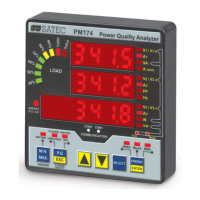21
Address Point ID Description
Low and High Scales
2
Units
2
Type R/W Notes
+39 0x1112 V1/V12 Voltage THD 0-999.9 0.1% UINT16 R
3
+40 0x1113 V2/V23 Voltage THD 0-999.9 0.1% UINT16 R
3
+41 0x1114 V3/V31 Voltage THD 0-999.9 0.1% UINT16 R
3
+42 0x1115 I1 Current THD 0-999.9 0.1% UINT16 R
3
+43 0x1116 I2 Current THD 0-999.9 0.1% UINT16 R
3
+44 0x1117 I3 Current THD 0-999.9 0.1% UINT16 R
3
+45 kVAh (low) 0-9999 1kVAh UINT16 R
6
+46 kVAh (high) 0-9999 10MVAh UINT16 R
6
+47 0x1609 Present kW import sliding window demand -Pmax-Pmax U3 UINT16 R
+48 0x160B Present kVA sliding window demand -Pmax-Pmax U3 UINT16 R
+49 0x1615 PF (import) at Max. kVA sliding window demand 0-1.000 0.001 UINT16 R
+50 0x111B I1 Current TDD 0-100.0 0.1% UINT16 R
3
+51 0x111C I2 Current TDD 0-100.0 0.1% UINT16 R
3
+52 0x111D I3 Current TDD 0-100.0 0.1% UINT16 R
3
NOTES:
1
When the 4LN3, 3LN3 or 3BLN3 wiring mode is selected, the voltages will be line-to-neutral; for any other wiring mode, they will be line-to-line voltages.
2
All analog registers except of harmonics are 1-second average values. For volts, amps and power scales and units, refer to Section 4 ”Data Scales and Units”. For analog data scaling
formulas and examples, see Section 2.6.1, “16-bit Scaled Integer Format”.
3
On a 3-s interval.
4
Positive readings of kvarh net.
5
Negative readings of kvarh net.
6
If you use these energy registers instead of 32-bit registers, limit the energy roll value to 8 digits (see Device Options Setup) to avoid overflow.

